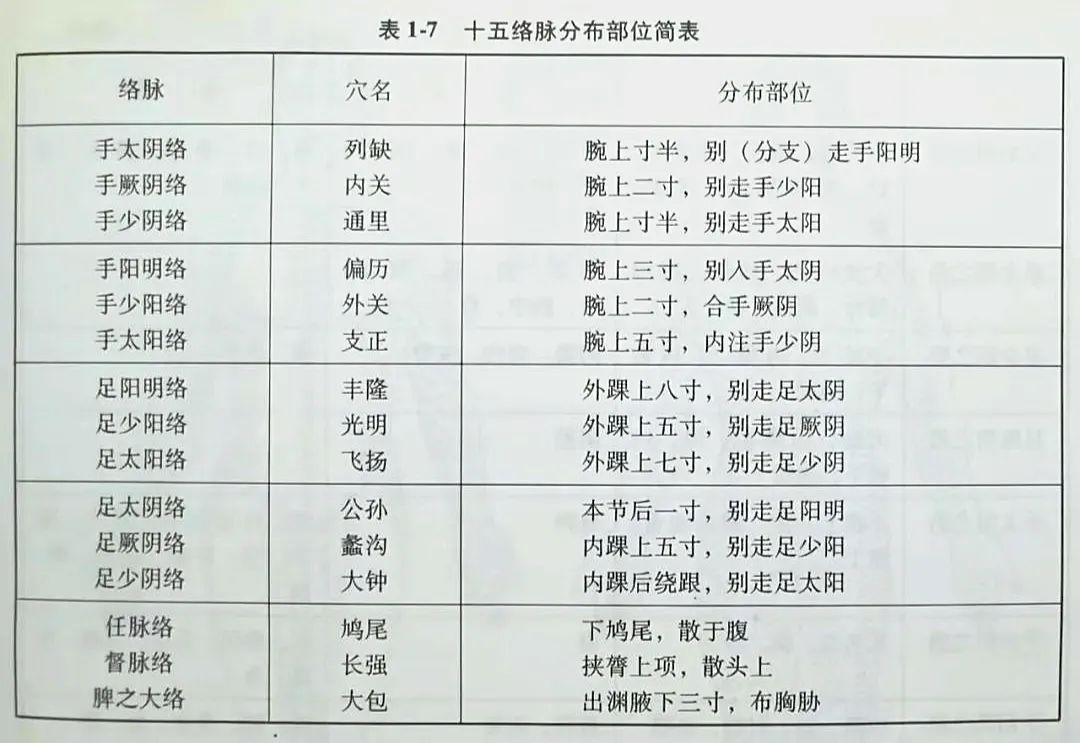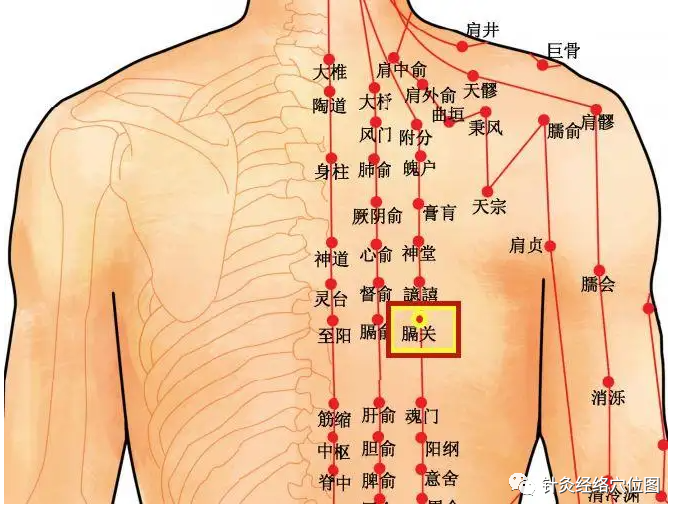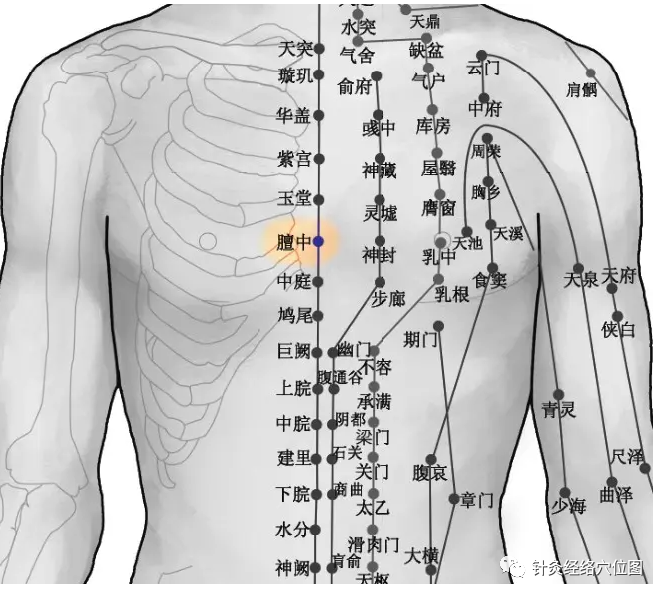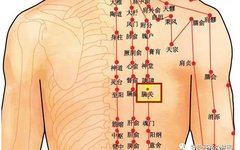Mastering the Use of the ‘Luo Points’ for Swift Therapeutic EffectsAuthor/Yang Chengqi, Narrated by Yang Liping
The fifteen luo points refer to the acupuncture points where the fifteen luo vessels branch from their respective primary meridians. The luo points of the twelve primary meridians are located below the elbow and knee joints in the limbs. The Ren meridian luo originates at the Jiuwei (鸠尾) point, the Du meridian luo originates at the Changqiang (长强) point, and the Spleen’s major luo emerges from the Daba (大包) point, collectively known as the fifteen luo points. The conditions treated by these luo points are often related to the pathologies of their corresponding meridians and the diseases traversed by the luo vessels themselves.

People’s Health Publishing House “Acupuncture (2nd Edition)”

To facilitate memorization, let us first review the mnemonic for the fifteen luo points:
The Lung luo is Lieque (列缺) for the Large Intestine,
The Spleen luo is Gongsun (公孙) for the Stomach (Foot Yangming),
The Heart luo is Tongli (通里) for the Small Intestine,
The Great Bell (大钟) luo is for the Kidney and Bladder (飞扬),
The Pericardium luo is Neiguan (内关) for the Sanjiao (三焦),
The Bright (光明) luo is for the Gallbladder and the Liguo (蠡沟) for the Liver,
The Spleen’s major luo is Daba (大包),
The Ren (任脉) luo is at Jiuwei (鸠尾) and the Du (督脉) luo at Changqiang (长强).
1. Acupuncture at the Pianli (偏历) Point for Treating Deafness and Tinnitus
Mr. Gao has suffered from deafness and tinnitus for over six months, with minimal effect from various treatments. On November 17, 1998, he sought acupuncture treatment from me.
The patient experienced deafness and tinnitus, especially at night when the sound of wind in the ears was incessant, affecting his sleep. His tongue was slightly red with little coating, and his pulse was deep, thin, and weak. Based on his symptoms and signs, the patient was diagnosed with Kidney and Liver Deficiency. I proceeded to needle Taixi (太溪) (bilateral), Sanyinjiao (三阴交) (bilateral), and Shenshu (肾俞) (bilateral) to nourish the Kidney and Liver; and used Tinggong (听宫) (bilateral) and Tinghui (听会) (bilateral) locally to regulate the auditory nerve.
After four acupuncture sessions, the patient reported no noticeable improvement. I recalled that the main luo vessel of the Hand Yangming Large Intestine meridian branches at a point called Pianli, which connects to the Hand Taiyin meridian and enters the ear, suggesting that treating deafness and tinnitus at this point should yield good results. Therefore, I added needling at both sides of the Pianli point.
After three more sessions, the patient reported a reduction in tinnitus, and after continuing acupuncture for ten more sessions, his long-standing deafness and tinnitus were completely cured.

2. Acupuncture at the Tongli (通里) Point for Treating Speech Impairment
Mr. Zhao, 67, experienced a stiff tongue and slurred speech upon waking, which alarmed him and his family, leading them to suspect a cerebrovascular accident. They rushed him to the hospital for a CT scan, which showed no abnormalities, and then sought my acupuncture treatment. The patient had normal limb movement but was unable to speak clearly, with a pale tongue and white coating, and a wiry, slippery pulse.
Phlegm obstructing the Lianquan (廉泉) point was evident. I needled Lianquan, Shanglianquan (上廉泉), and Tiantu (天突) locally to clear the meridians and resolve phlegm; I also needled Fengchi (风池) (bilateral) and Fenglong (丰隆) (bilateral) to calm wind and transform phlegm.
After five sessions, his speech improved but was still not satisfactory, so I added needling at the Tongli point (bilateral). After three more sessions, his symptoms significantly improved.
[Note] The Tongli point is a luo point of the Hand Shaoyin meridian, which branches along the Hand Shaoyin primary meridian, ascending to the heart, and then further to the root of the tongue, belonging to the eye system. It is indicated for sudden loss of voice, heart disease, and stiff tongue.
3. Acupuncture at the Feiyang (飞扬) Point for Treating Nosebleeds
Mr. Guo experienced nasal bleeding for six to seven days, with a small amount of blood, and noticed blood when blowing his nose. By noon, he had some dripping blood. After taking hemostatic medication for two days without effect, he sought my treatment on September 15, 1989.
The patient appeared flushed, with blood in his nasal cavity, a red tongue, thin white coating, and a surging pulse. Based on his symptoms and signs, he had internal heat causing blood to recklessly flow.
The nasal cavity belongs to the Lung, and nasal bleeding is undoubtedly due to Lung heat. I prescribed three doses of cooling blood-clearing herbal medicine, thinking that since the nosebleed was not severe, these three doses would surely cure him. However, on the 18th, the patient returned, stating that after finishing the three doses, the nasal bleeding had not stopped.
I had no choice but to check his pulse and tongue again, discovering that although the pulse was surging, it was weak upon deep pressure; the tongue was red, but the coating was thin and white, leading me to suspect that the internal fire was due to deficiency rather than excess. I intended to prescribe a few doses of yin-nourishing, fire-reducing, and blood-cooling herbal medicine, but suddenly recalled a reference in an acupuncture text stating that needling the Feiyang point can treat deficiency-type nosebleeds.
The Feiyang point is a luo point of the Foot Taiyang Bladder meridian, which branches into the Foot Shaoyin Kidney meridian. Needling this point can nourish the Kidney and indirectly achieve the effects of nourishing yin, reducing fire, and cooling blood. Therefore, I needled the Feiyang point, retained the needle for 30 minutes after obtaining qi, and treated him twice. By noon, the nasal bleeding had stopped, and after two more sessions, the blood-stained nasal discharge was resolved.
4. Acupuncture at the Dazhong (大钟) Point for Treating Kidney Deficiency and Low Back Pain
Mr. Zhang, 55, had suffered from low back pain for many years. In the autumn of 1978, due to excessive labor, his back pain worsened, making it difficult for him to turn or work in the fields. However, the farming work could not wait, as he had four to five acres of wheat to sow, and time was running out. On October 6, he sought my help to alleviate his back pain quickly so he could lead his family in the autumn harvest and sowing.
The patient had a long history of low back pain, which worsened with exertion, accompanied by weakness in the lower back and knees, excessive sweating, and aversion to wind. His tongue was pale with a thin white coating, and his pulse was deep, thin, and weak. After comprehensive diagnosis, I concluded that the patient had Kidney deficiency causing low back pain.
I needled the Dazhong point (bilateral), using the burning mountain fire technique twice after obtaining qi, and retained the needles for 30 minutes. After one session, the patient could turn his back and reported reduced pain. He returned for two more sessions on the following days, and by the third day, he was able to work in the fields.
[Note] The Dazhong point is a luo point of the Foot Shaoyin Kidney meridian, which can tonify the Kidney, activate circulation, and relieve pain. This point is effective for treating low back and spinal pain.
5. Acupuncture at the Gongsun (公孙) Point for Treating Abdominal Distension
Ms. Huo had experienced abdominal distension for over a month. She had taken Western medicine to enhance gastric motility and Chinese medicine to regulate qi, but neither had satisfactory results. On July 7, 2002, she came to me for treatment.
The patient was a 45-year-old woman from a farming family, who claimed to work harder than her peers. A month ago, she began experiencing abdominal distension, belching with sour fluid, and loss of appetite, and her physical strength had declined day by day. Now, even slight physical activity made her sweat profusely and feel breathless.
Interestingly, while others with abdominal distension would regain their appetite after some activity, she found that the more she moved, the worse her abdominal distension became, and her appetite decreased.
Upon percussion, her epigastric area produced a drum-like sound, her tongue was pale with a white coating, and her pulse was slow and weak. After comprehensive diagnosis, I concluded that the patient had a weak Spleen and Stomach, with impaired transportation and a failure to harmonize and descend.
Thus, I needled Zusanli (足三里) (bilateral) to strengthen the Spleen and boost qi, and Shangwan (上脘), Zhongwan (中脘), and Xiawan (下脘) to assist in transportation, relieve abdominal distension, and increase appetite. After the first session, the patient felt some relief in her epigastric area, but after three more sessions, the effect was not as good as the first, and she still experienced abdominal distension, loss of appetite, and sour belching.
I recalled that the Gongsun point is a luo point of the Foot Taiyin Spleen meridian, which branches into the Yangming meridian and has the function of strengthening the Spleen, benefiting the Stomach, and eliminating phlegm and accumulation. During the fourth session, I added needling at the Gongsun point, and after needling, the patient reported that her epigastric area felt more comfortable than before. After four more sessions, her abdominal distension, sour belching, and loss of appetite were resolved.
6. Acupuncture at the Lieque (列缺) Point for Treating Palmar Heat
Ms. Huo had experienced palmar heat for over six months and had consulted several doctors, all of whom diagnosed it as Yin deficiency with excessive fire. She took several boxes of Zhibai Dihuang Wan and consumed some yin-nourishing and blood-cooling herbal medicine, but the results were mediocre. On March 18, 2000, she sought my treatment.
She reported that the palmar heat occurred day and night; examination of her tongue and pulse showed no significant changes. I needled both sides of the Lieque point, retaining the needles for 30 minutes after obtaining qi. After two sessions, the patient felt a reduction in palmar heat, and after five more sessions, her palmar heat was completely cured.
[Note] The Lieque point is a luo point of the Hand Taiyin Lung meridian, which branches at the wrist and runs into the palm, dispersing at the edge of the thenar eminence. Diseases of the palm and hand are often related to this luo vessel, so needling the Lieque point can yield ideal results.
7. Acupuncture at the Fenglong (丰隆) Point for Treating Sudden Loss of Voice
Mr. Zhang suddenly lost his voice during an argument with a neighbor and rushed to the clinic for treatment. I found his pulse to be wiry and rapid, suspecting that his emotional distress had harmed the Liver, leading to a failure in its ability to disperse.
I needled Lianquan and Tiantu to stimulate the throat area to open the throat and restore voice; Taichong (太冲) (bilateral) and Yanglingquan (阳陵泉) (bilateral) to soothe the Liver and relieve depression. The next day, the patient returned with the same symptoms, and I advised him to undergo a CT scan at the county hospital, which returned normal results.
I considered that the main luo vessel of the Foot Yangming meridian branches at a point called Fenglong, which connects to the Foot Taiyin meridian. Another branch runs along the outer edge of the tibia to the head and neck, converging with the qi of other meridians in that area, and descends to the throat. Could the sudden loss of voice be due to a pathological change in the Foot Yangming Stomach meridian?
I decided to needle both sides of the Fenglong point, retaining the needles for 15 minutes after using a reducing technique for 2 minutes. After treatment, the patient was able to speak again, and after three more sessions, his speech returned to normal.
8. Acupuncture at the Jiuwei (鸠尾) Point for Treating Abdominal Itching
Ms. Wu, 36, experienced itching of the abdominal skin and had taken several antihistamines with little effect. She also tried several doses of herbal medicine to dispel dampness and relieve itching, but to no avail. On February 8, 1999, she sought my treatment. Upon examination, her abdominal skin color was unchanged, with no rashes or papules, and her tongue and pulse showed no specific findings. Learning from the previous failed treatments, I pondered the best approach for this condition.
With no changes in skin color or rashes, antihistamines would certainly be ineffective; and with no changes in tongue and pulse, dispelling dampness and relieving itching or nourishing blood would also be unreasonable.
I recalled that the main luo vessel of the Ren meridian branches at a point called Jiuwei, which disperses in the abdominal area. If a pathological change occurs, the symptoms of excess would be abdominal pain; the symptoms of deficiency would be abdominal skin itching. Could I use the Jiuwei point for treatment?
I needled the Jiuwei point with a 1.5-inch needle, retaining it for 30 minutes after obtaining qi. After two treatments, the patient reported a reduction in abdominal itching, and after two more sessions, the itching was completely resolved.
9. Acupuncture at the Liguo (蠡沟) Point for Treating Scrotal Itching
Mr. Zhao sought treatment for scrotal itching on November 9, 1999. Upon examination, his tongue was pale with a thin white coating, and his pulse was deep, thin, and weak. He reported weakness in his lower back and knees, and decreased libido, leading me to believe this was due to Kidney Yang deficiency and dampness descending. I prescribed seven doses of warming Kidney and dispelling dampness herbal medicine. After finishing the course, the patient reported no significant changes.
I considered that the Foot Jueyin Liver meridian has a branch that runs through the lower limbs to the testicles, converging in the penis. If a pathological change occurs, the symptoms of excess would be testicular swelling and sudden pain, while the symptoms of deficiency would be scrotal itching.
The luo point for this condition is the Liguo point, so I decided to needle the Liguo point, retaining the needles for 30 minutes after obtaining qi. The next day, the patient reported a reduction in scrotal itching, and I continued acupuncture for six sessions, resulting in complete resolution of the scrotal itching.
10. Acupuncture at the Daba (大包) Point for Treating Generalized Pain
Mr. Li experienced generalized pain and had taken antipyretic and analgesic medication for several days with only temporary relief. On November 5, 1988, he sought my treatment. His body temperature was 36.5°C, and his tongue and pulse were normal, indicating that this condition was neither an exterior syndrome nor rheumatism, making it difficult to treat with medication.
I considered that the Spleen’s major luo disperses in the chest and ribs; if a pathological change occurs, the symptoms of excess would be generalized pain; the symptoms of deficiency would be weakness and lack of strength in the joints. The Daba point is a luo point of the Foot Taiyin Spleen meridian.
Thus, I needled both sides of the Daba point, using strong stimulation for 2 minutes after obtaining qi, and retaining the needles for 30 minutes. After three sessions, the generalized pain decreased, and after five more sessions, the patient felt much better.
11. Acupuncture at the Feiyang (飞扬) Point for Treating Pain in the Head and Neck
Mr. Ge sought treatment for pain in the head and neck, along with nasal congestion and clear nasal discharge, on December 12, 1991. Upon examination, there were no significant changes in his tongue and pulse, and his body temperature was normal. However, based on his symptoms, it was clear that he had a cold, so I prescribed antipyretic and analgesic medication along with antiviral drugs. After two days, the results were mediocre.
After taking the medication, he felt better, but four hours later, the pain in his head and neck returned. I needled both sides of Fengchi (风池), Fengfu (风府), Quchi (曲池), and Dazhui (大椎) to disperse wind and relieve pain, continuing to take antipyretic and analgesic medication and antiviral drugs. After two days, the results were still average.
Later, I thought that if the luo vessel of the Foot Taiyang Bladder meridian were to undergo a pathological change, the symptoms of excess would be nasal congestion and clear nasal discharge, while the symptoms of deficiency would be nasal bleeding.
Thus, I needled both sides of the Feiyang point, stopping the needling of Fengfu, Quchi, and Dazhui. After obtaining qi, I used strong stimulation for 2 minutes and then withdrew the needles. After treatment, he reported a significant reduction in pain in the head and neck, and after two more sessions, the pain was completely resolved.
[Note] The Feiyang point is a luo point of the Foot Taiyang Bladder meridian, effective for treating pain in the head and neck.
12. Acupuncture at the Lieque (列缺) Point for Treating Frequent Yawning
Mr. Guo, 52, had been yawning frequently for the past ten days without any obvious cause. He could not go more than 40 minutes without yawning, sometimes yawning two or three times in a row. On December 24, 1988, he sought my treatment.
Upon checking his pulse and tongue, there were no specific changes, and he had normal limb movement. I needled both sides of the Lieque point, retaining the needles for 30 minutes. After three sessions, the yawning decreased, and he could sometimes go two to three hours without yawning. After five more sessions, the yawning completely stopped.
[Note] Frequent yawning is often considered by Western medicine to be caused by brain hypoxia. I believe this condition is primarily related to the descent of the Zongqi (宗气). The Lung governs qi, and the Lieque point is a luo point of the Hand Taiyin Lung meridian, which treats Lung disorders. Using a tonifying technique can help elevate the Zongqi.
13. Acupuncture at the Zhizheng (支正) Point for Treating Tennis Elbow
Mr. Hu, 34, experienced pain on the outer side of his right elbow, with difficulty in flexion and extension. The pain worsened when gripping or lifting objects. After being diagnosed with tennis elbow by several doctors, he took some medication that slightly alleviated the symptoms, but the pain returned when he stopped taking the medication. He had also received injections but had not been cured. On May 12, 1986, he sought my treatment.
Upon examination, his tongue and pulse showed no significant changes. Considering the patient was young and strong, I needled both sides of the Zhizheng point, using strong stimulation for 2 minutes after obtaining qi, retaining the needles for 15 minutes, and then using strong stimulation for 1 minute before withdrawing the needles. After five sessions, the pain in the elbow decreased, but he still felt soreness when gripping or lifting. As the treatment was not effective, I continued acupuncture at the Zhizheng point, using the same technique, and after a total of ten sessions, the tennis elbow was cured.
[Note] Tennis elbow, also known as lateral epicondylitis, is caused by intense and frequent activity of the elbow and wrist joints, leading to local tearing or chronic aseptic inflammation of the extensor muscles’ origin.
The Zhizheng point is a luo point of the Hand Taiyang Small Intestine meridian, which branches out to the elbow. Strong stimulation at this point can promote blood circulation in the elbow area, aiding in the repair of local tears or the absorption of aseptic inflammation.
14. Acupuncture at the Neiguan (内关) Point for Treating Stiff Neck
Ms. Liu, a woman in her sixties, had been experiencing difficulty in turning her neck for several days, with only mild pain but significant stiffness. On June 7, 1979, she sought my treatment.
Upon examination, her tongue was pale with a thin white coating, and her pulse was weak, with no other pathological symptoms evident. I needled both sides of Fengchi, both sides of Lieque, and Dazhui, retaining the needles for 20 minutes. After three consecutive treatments, there was no improvement. The patient had lost confidence in the treatment, and I was at a loss.
Suddenly, I recalled that my mentor had mentioned that the luo vessel of the Hand Jueyin Pericardium may manifest as neck stiffness when it is deficient. I needled the Neiguan point (bilateral), retaining the needles for 30 minutes without additional stimulation, and treated her every other day. After three more sessions, her neck movement improved significantly, and the patient regained confidence, continuing with five more sessions until her neck movement returned to normal.
15. Acupuncture at the Guangming (光明) Point for Treating Weakness in the Left Foot
Mr. Chen, 36, had been feeling weakness in his left ankle for several days. Although walking was not affected, he felt soreness in the ankle when walking, fearing he might fall, but in reality, he was able to walk without issues. On November 4, 1990, he sought my treatment.
After comprehensive diagnosis, aside from the symptoms reported by the patient, no changes were observed. Concerned about possible cerebrovascular issues, I sent him for a CT scan, which returned normal results. After he returned, I prescribed Liuwei Dihuang Wan, Vitamin B1, and Adenosine B12, but after five days, there was no change.
I then needled the Guangming point on the left side, retaining the needles for 30 minutes. After three days of treatment, the patient reported increased strength in his left ankle. After four more days of acupuncture, he felt almost normal.
[Note] The Guangming point is a luo point of the Foot Shaoyang Gallbladder meridian, effective for treating eye disorders and lower limb weakness. I often select this point for treating conditions below the ankle joint with significant results.
Give a thumbs up and let’s work together for health!
_Follow us below for more information
Light it up to let more people see👇

